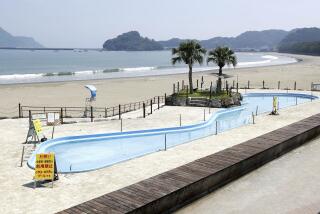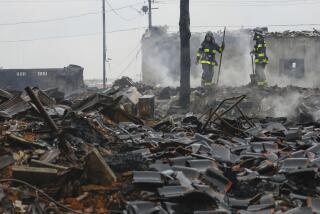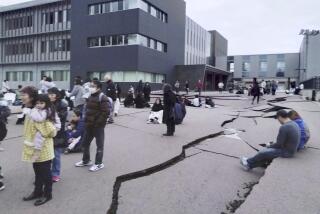Japan raises nuclear crisis rating to highest level
- Share via
Reporting from Tokyo and Rikuzentakata, Japan — Japanese nuclear regulatory officials Tuesday raised the severity rating at the earthquake- and tsunami-damaged Fukushima Daiichi power plant to the highest level by international standards, equaling the 1986 Chernobyl meltdown in the former Soviet Union.
The country’s Nuclear and Industrial Safety Agency announced that because of the amount of radioactive material released from the plant after the magnitude 9 earthquake a month ago, the rating would be changed to level 7, a “major accident” on the International Atomic Energy Agency’s scale, up from a level 5, an “accident with wider consequences.”
Photos: Covering the Japan earthquake aftermath
In a nationally televised news conference, the agency’s spokesman, Hidehiko Nishiyama, said the decision was based on the amount of radioactive iodine and cesium spewed from the power plant in Fukushima, north of Tokyo.
Nishiyama stressed that the radiation from the Fukushima nuclear plant was 10% of the amount at Chernobyl. He also said that unlike at Chernobyl, there had been no deaths linked to the accident at Fukushima.
“At Chernobyl, the reactor itself exploded,” he said. “At Fukushima some radioactivity has leaked from the reactor, but the reactor itself continues to keep most of the radioactive material inside. In that sense, this is different from Chernobyl.”
Before the rating was elevated, the disaster had been rated at the same level as the 1979 Three Mile Island accident near Middletown, Pa.
But Minoru Ogoda of Japan’s Nuclear and Industrial Safety Agency said the change in the severity rating came because “the impact of radiation leaks has been widespread from the air, vegetables, tap water and the ocean,” the Associated Press reported.
Measuring severity on the international scale involves factors including the amount of radiation released, how wide an area it reaches and how long any problems may last.
Officials said the rating reflects the severity of the problem at the outset, when radiation levels were highest. Those levels have since fallen sharply, they said.
Experts, nevertheless, say it will take years to recover from the damage incurred at the Fukushima plant.
More than 27,000 people were left dead or missing as the disaster last month, centered in the northeast, destroyed fishing towns and caused severe damage to homes, businesses and almost everything else along more than 200 miles of coastline. The government has estimated economic losses of as much as $300 billion, not including costs such as the cleanup of the Fukushima plant, which is operated by Tokyo Electric Power Co.
The announcement by nuclear agency officials came the day after three powerful aftershocks struck already jittery northeastern Japan within the span of 10 minutes, as the government announced new plans to expand the evacuation area near the stricken nuclear plant due to high radiation levels.
Japan is trying to rebuild after the March 11 quake triggered a deadly tsunami that also left tens of thousands homeless. The tsunami has caused several fires and explosions at the Fukushima Daiichi plant, which has leaked dangerous isotopes into the air, soil and water.
The first of Monday’s temblors, which trapped some victims in collapsed homes and vehicles, hit at 5:16 p.m. near the coast in Fukushima prefecture, registering a magnitude 7.1 at a depth of 6 miles underground, according to the Japan Meteorological Agency.
It was sizable enough to rock buildings in Tokyo, about 150 miles to the south. A magnitude 6 quake hit a minute later in the same area, followed by another temblor, measuring magnitude 5.6, nine minutes after that.
Aftershocks continued hours later, the agency said. In neighboring Ibaraki prefecture, one man died after falling and hitting his head during the shaking, according to the local Ryugasaki fire department.
The quakes also triggered a landslide that buried three homes in Iwaki city. Two people died in the landslide, including a 16-year-old girl, according to public broadcaster NHK. Three other men pulled from the rubble were unconscious and taken to a hospital, NHK said. Rescuers continued their efforts Tuesday.
Officials issued a tsunami warning after the quakes but later lifted it.
The quakes temporarily knocked out the power to the Fukushima plant and led to a 50-minute stoppage in the water-spraying operations to cool four of the plant’s six reactors. Highways were closed, bullet train services to the region were halted briefly, and as many 220,000 homes in Fukushima prefecture were without power.
Tokyo Electric Power Co. said a fire broke out on the plant’s premises Tuesday morning at a building where batteries are stored. Within minutes, firefighters put out the blaze, and there appeared to be no impact on workers’ efforts to cool four of the reactors, the company said in a statement.
On Monday, Chief Cabinet Secretary Yukio Edano said the government would expand a 12-mile evacuation area near the nuclear plant, adding to the ranks of the thousands who have already been told to leave their homes.
Unlike the government’s previous evacuation orders, the new one is based on data that show higher than normal radiation levels extending to towns and villages that lie beyond the 12- to 18-mile zone around the plant. The government has advised residents in the zone to stay indoors.
It was unclear how many residents would be affected by the new order, which the government plans to carry out over the next month. Edano noted that the risk of a massive radiation leak from the Fukushima plant was “considerably lower.”
Photos: Covering the Japan earthquake aftermath
Special correspondent Hall reported from Tokyo and Times staff writer Glionna from Rikuzentakata.
More to Read
Sign up for Essential California
The most important California stories and recommendations in your inbox every morning.
You may occasionally receive promotional content from the Los Angeles Times.











